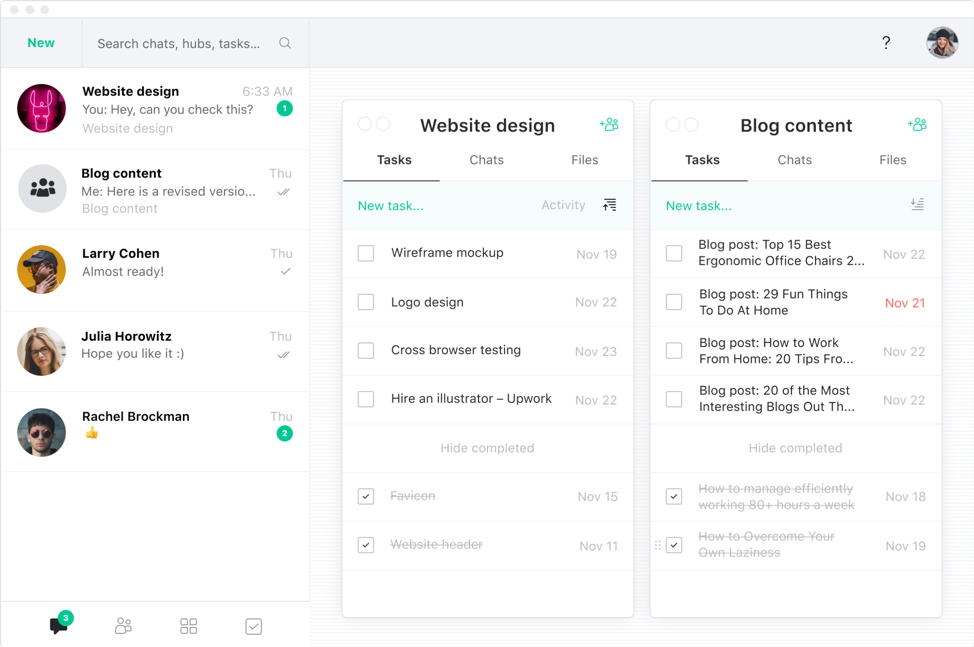How to Choose the Right Team Collaboration Tool

How to Choose the Right Team Collaboration Tool
Contributed ContentTeam collaboration tools can efficiently benefit businesses. To choose the right collaboration tools, start by identifying the business needs and users for those tools, then involve the users throughout the choosing process.
Our research team canvassed the tech market for the best team collaboration tool. They came up with a shortlist that we tried out over a span of two years. Turns out, the market is flooded with great tools for team collaboration. But in such a space with so many alternatives to choose from, organizations are frequently spoilt for choice.
Companies can use collaborative software tools to achieve increased efficiency, productivity and competitiveness – the question on how to choose the right tool remains a challenge.
4 Tips for Choosing the Right Collaboration Tool
- Identify the areas that could benefit from using tools
- Involve user opinion for evaluation
- Consider the tool’s software compatibility
- Measure the expected change
1. Identify Areas That Could Benefit From Using Tools
Whether you’re a startup or a large enterprise, the business is likely to have various pain points with different priority levels. The first step is to identify these pain points.
Take the time to chat with your team, prospects, and existing customers. Ask each of these groups open-ended questions that allow them to provide information in the form of their own opinions and wishes. When you have that data, arrange their needs in order of priority.
While identifying these problem areas, you’ll also be identifying who is going to use the collaboration tool in question.
Let’s say that your team has been taking longer to complete projects because of delayed feedback from clients or that sometimes customers complain about the services or products given to them not exactly matching their specifications.
This would be a case of miscommunication or delayed feedback, which is quite common with email communication. Collaboration on client-facing files or instant feedback would help to solve these miscommunication problems.
Alternatively, you might find that your teams spend more time managing tasks instead of getting things done. A team collaboration tool like Brief that enables team members to prioritize and focus on important tasks while minimizing distractions could be what you need.
As seen in the image below, the tool combines chats, video, tasks & file sharing in one simple and elegant dashboard.

With this, users don’t have to move from their workspace to send an email before resuming what they were doing. Brief enables users to get it all done with ease from the same dashboard.
After identifying the problem areas, the next thing to do is look for the tools that match the identified needs.
2. Involve User Opinion in Evaluation
Don’t start by picking tools that you think will work. First, get the users involved in choosing the tools. The idea is to get buy-in from these people to seal up any loopholes for complaints arising later on.
Involving users in selecting these collaboration tools also helps prepare the ground for the deployment process. By so doing, you can be assured of a quicker onboarding process with fewer incidents and minimal room for costly rejection.
A survey is still a tried and true way to easily get people involved. Often, you could simply prepare standardized questionnaires and hand them out to get feedback on a select number of tools.
Sometimes people will choose tools based on familiarity. When picking the right collaboration tool, provide the people with some education to help them understand what is possible, and how the comparing collaboration features might really help them.
While many people may be familiar with Skype, you may find that GoToMeeting is fairly more robust as an online meeting and video conferencing tool. Like Skype, it will enable businesses to share screens and collaborate quite effectively with others in real-time.
Along with doing your own homework, you can hire an external company to conduct systematic surveys and interviews with the users. In the end, you’ll have an overview of what the team members' or users’ preferences are.
When you’re close to making your decision, ensure that the tools have the following:
- Offer a free trial, along with the support that works for your business.
- Are intuitive and easy to use; you can actually set it up with little help from the vendor hence saving you money and time.
- Have the more cost-effective delivery option (will you buy or lease, install on-premise or use as SaaS?).
- Have crucial security features.
- Requires little training to onboard the users.
- Have a mobile app that allows members to collaborate on the go
- Have clear pricing with no hidden costs.
These criteria should be easily found on the tool’s platform. But do what is right for your business and team. If the majority of the people prefer or are obviously excited about a particular tool, give it to them.
3. Consider the Tool’s Software Compatibility
Chances are that at this point, you have a shortlist of tools that meet your needs and are acceptable to your users. Just before you settle on your final pick, it’s important to consider if it will actually be possible to deploy the solution in light of your current software establishment.
Will the collaborative tool work easily with the other software systems currently within the organization? How will it fit in? Will you have to manually transfer data into the new platform or does it have the required integrations to make everything seamless?
Even if it means paying more upfront, be sure to go for software that includes more of the features and functionalities that are essential to your business needs.
4. Measure the Expected Change
Every new solution will have an impact. The idea is to ensure that you get a solution that helps make the lives of users easier, not the other way around. And they need to perceive it as such. Here are the steps to follow:
- Engage stakeholders
- Connect with program designers
- Focus the evaluation
- Confirm resources & expectations
- Determine data collection methods
- Plan for communication results

If users are involved in business needs and evaluating a shortlist of tools then the decision is simpler. Once all of these points are considered, the tool for you and your business should be an easy choice.
Find a Collaborative Tool That Fits Your Team
Whether employees are working remotely or not, collaboration is now a mainstream in most organizations. Your choice of collaboration tools can make or break productivity.
Following this guide is the first step to seeing your productivity soar.
